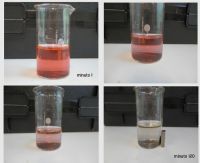Nanostructures to facilitate the process to eliminate organic contaminants in water

Dissolution process of organic particles through nanoparticles Nafarroako Unibertsitate Publikoa.
The nanostructures (particles of a microscopic size of between 1 and 100 nanometres) are coated in titanium oxide to which nitrogen has been added. This allows sunlight, rather than ultraviolet radiation, to trigger the process involving the chemical reaction and destruction of contaminants.
What is more, thanks to the magnetic nucleus of the particles, once the process has been carried out, they can be retrieved and reused. Silvia Larumbe’s thesis is entitled: “Síntesis, caracterización y aplicaciones de nanoestructuras basadas en óxidos de metales de transición” [Synthesis, characterisation and applications of nanostructures based on transition metal oxides].
The basis of the research conducted is the phenomenon known as photocatalysis: when light affects a substance that acts as a catalyst, the speed of the chemical reaction is increased. In this case, the light activates the titanium oxide and different oxidizing radicals are formed; the latter destroy the organic contaminants in the water, which could be colouring agents, solvents, detergents, etc.
As the author of the work explained, “it is a sustainable system that could be used as an alternative to different treatments used traditionally in waste water treatment and, specifically, to eliminate certain organic contaminants”.
One of the advantages of this development is the possibility of using sunlight instead of ultraviolet light. “Since nitrogen is added to the coating of the particles, the mechanism that will trigger the process can be sunlight rather than ultraviolet radiation, which means a more accessible, less expensive alternative that poses fewer risks.”
The fact that structures of a nanometric size are used also improves photocatalytic capability since the surface of the photocatalyst is greater. Another advantage is the reuse of the catalysing component; since the nanostructures are formed using a magnetic nucleus, they can be retrieved by applying an external magnetic field.
Notes
Silvia Larumbe graduated in Chemistry at the University of Navarre, did a Master’s in Chemical Science and Technology at the UNED (Open University) and obtained her PhD in the Department of Physics of the NUP/UPNA. She has participated in over twenty or so national and international conferences, is the co-author of twelve research papers, and has participated in various research projects.
- Internet reference
- www.unavarra.es/actualidad/berriak?contentId=181084
- References
- C. Gómez-Polo, S. Larumbe, J.M. Pastor. (2013). “Room temperature ferromagnetism in non magnetic doped TiO2 nanoparticles”. Journal of Applied Physics 113 17B511
Media Contact
All latest news from the category: Physics and Astronomy
This area deals with the fundamental laws and building blocks of nature and how they interact, the properties and the behavior of matter, and research into space and time and their structures.
innovations-report provides in-depth reports and articles on subjects such as astrophysics, laser technologies, nuclear, quantum, particle and solid-state physics, nanotechnologies, planetary research and findings (Mars, Venus) and developments related to the Hubble Telescope.
Newest articles

Trotting robots reveal emergence of animal gait transitions
A four-legged robot trained with machine learning by EPFL researchers has learned to avoid falls by spontaneously switching between walking, trotting, and pronking – a milestone for roboticists as well…

Innovation promises to prevent power pole-top fires
Engineers in Australia have found a new way to make power-pole insulators resistant to fire and electrical sparking, promising to prevent dangerous pole-top fires and reduce blackouts. Pole-top fires pose…

Possible alternative to antibiotics produced by bacteria
Antibacterial substance from staphylococci discovered with new mechanism of action against natural competitors. Many bacteria produce substances to gain an advantage over competitors in their highly competitive natural environment. Researchers…





















